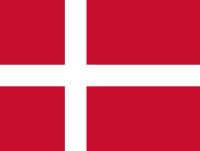|
Vikidia currently has 4,621 articles. Improve it! |
|
Join Vikidia: create your account now and improve it! |
Denmark
| Denmark | |||
|
| |||
| Official languages Capital |
Danish Copenhagen | ||
| Area Government |
42,915.7 km2 Constitutional monarchy | ||
| Population Religion |
5,602,536 Danish 90%, other European 7%, Black or Muslim 3%. Lutheran (62%) other Protestant (10%), None 28% | ||
| Time zone Currency |
CET (UTC+1) Danish krone | ||
| Demonym |
Danish, Dane | ||
| Monarch |
Current Previous |
Frederik X Margrethe II | |
Denmark is a country in northern Europe. It shares a border with Germany and is connected to Sweden by a road and rail bridge. Denmark is a member state of the European Union and part of the Scandinavian countries.
Denmark consists of a mainland and hundreds of islands. The capital city is Copenhagen. Other big cities in Denmark are Århus and Odense. Denmark has been a member of the European Union since 1973 and uses the Danish Krone as its currency.
History[edit | edit source]
People have lived in Denmark since around 12,500 BCE. Over time the original population mixed with people from other parts of Scandinavia, the British Isles (United Kingdom and Ireland) and other nearby countries. Between the 8th and 10th century CE The Vikings (the name the Danish were known as at this time) invaded, traded with, discovered and fought people in other parts of Europe and North America. The Vikings discovered North America in the 10th century - over 400 years before Christopher Columbus (see Vinland).
In later centuries Denmark was associated with neighbouring countries and there was for many hundreds of years a union between Denmark, Sweden and Norway. During World War II Denmark was occupied by Germany while its main colonies of Greenland and Iceland were occupied by the British and the USA. After the war Iceland became an independent country.
Denmark has been a member of the European Union since 1973 joining at the same time as the UK and Ireland.
Geography[edit | edit source]
Denmark has thousands of islands including 443 which are named. Denmark is a very flat country and its highest mountain is Møllehøj, at 171 metres. Because of Denmark's indented coast and thousands of islands, Denmark has a coastline of over 7,300 kilometres. The climate in Denmark is temperate and the country experiences cold winters and cool summers.
The Øresund Bridge connects the island of Zealand (where the capital is located) with Sweden measuring almost 8km in total. No location in Denmark is more than 52km from the sea.
People[edit | edit source]
Over 5.8 million people live in Denmark. The majority of people in Denmark are of Danish descent, but there are small minorities from South Asia and the Middle East. Inuit people from Greenland and people from the Faeroe Islands (both territories are possessions of Denmark) also exist in Denmark. The national language is Danish.
Around 75-80% of the population are members of the Church of Denmark, which is a Lutheran Christian church and the official religion of Denmark. Many members of the Church of Denmark are not religious, but choose to stay in the church because it takes time to leave and because the only downside to being a member is that you have to pay a small church tax. For this reason, many people stay in the Church of Denmark but are atheist or even member of another religion. About 20% of Danish people say they are atheist. 3% are Muslims, 0.7% are Catholic Christians, and 0.1% are Jews.
The most popular sports in Denmark are Association football (soccer), handball, sailing, and badminton. Handball was invented in Denmark.
Like many other countries in northern Europe, Denmark is a monarchy. The present monarch is King Frederik X, who became King on the 14th January, 2024. He took over from his mother, Queen Margrethe II, who in her annual address to the people of Denmark, on New Year's Eve 2023, announced her intention to abdicate the throne on 14th January 2024.
As is customary in the country, there was no public coronation, but more simply, King Frederik X's accession was announced to the nation via radio and through newspapers, and the whole event was broadcast live on the Danish state broadcaster, DR1.
Sights[edit | edit source]
Denmark is a popular destination for tourists and is very popular for short trips for visitors from Sweden, Norway, Germany and the United Kingdom. Denmark's many sandy beaches attract large numbers of Germans and the capital city Copenhagen is popular with others especially tourists from the UK and Sweden.
Denmark is home to 3 UNESCO World Heritage Sites including: Kronborg Castle and Roskilde Cathedral.
| Europe Portal — All articles about countries in Europe, traditions, monuments, and more! |
States and dependencies of Europe
States: Albania · Andorra · Armenia · Austria · Azerbaijan · Belarus · Belgium · Bosnia and Herzegovina · Croatia · Cyprus · Czech Republic · Denmark · Estonia · Finland · France · Georgia · Germany · Greece · Hungary · Iceland · Ireland · Italy · Latvia · Liechtenstein · Lithuania · Luxembourg · Malta · Moldova · Monaco · Montenegro · Netherlands · North Macedonia · Norway · Poland · Portugal · Romania · Russia · San Marino · Serbia · Slovakia · Slovenia · Spain · Sweden · Switzerland · Turkiye · Ukraine · United Kingdom · Vatican City
States with limited recognition: Abkhazia · Artsakh · Kosovo · Northern Cyprus · South Ossetia · Transnistria
Dependencies: Åland Islands · Akrotiri and Dhekelia · Faroe Islands · Gibraltar · Guernsey · Isle of Man · Jersey · Svalbard




